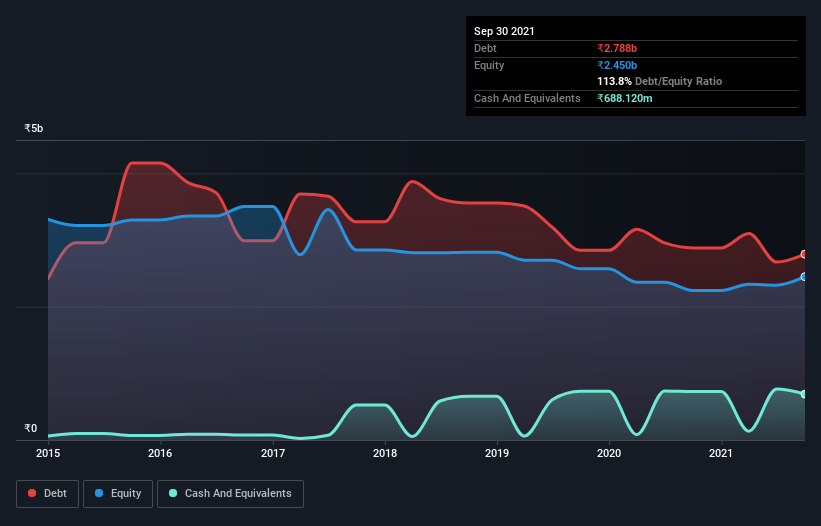These 4 Measures Indicate That Suryalakshmi Cotton Mills (NSE:SURYALAXMI) Is Using Debt Extensively

The external fund manager backed by Berkshire Hathaway's Charlie Munger, Li Lu, makes no bones about it when he says 'The biggest investment risk is not the volatility of prices, but whether you will suffer a permanent loss of capital.' So it seems the smart money knows that debt - which is usually involved in bankruptcies - is a very important factor, when you assess how risky a company is. We note that Suryalakshmi Cotton Mills Limited (NSE:SURYALAXMI) does have debt on its balance sheet. But should shareholders be worried about its use of debt?
Why Does Debt Bring Risk?
Debt and other liabilities become risky for a business when it cannot easily fulfill those obligations, either with free cash flow or by raising capital at an attractive price. Ultimately, if the company can't fulfill its legal obligations to repay debt, shareholders could walk away with nothing. However, a more frequent (but still costly) occurrence is where a company must issue shares at bargain-basement prices, permanently diluting shareholders, just to shore up its balance sheet. Of course, plenty of companies use debt to fund growth, without any negative consequences. The first thing to do when considering how much debt a business uses is to look at its cash and debt together.
Check out our latest analysis for Suryalakshmi Cotton Mills
What Is Suryalakshmi Cotton Mills's Net Debt?
The chart below, which you can click on for greater detail, shows that Suryalakshmi Cotton Mills had ₹2.79b in debt in September 2021; about the same as the year before. However, because it has a cash reserve of ₹688.1m, its net debt is less, at about ₹2.10b.

A Look At Suryalakshmi Cotton Mills' Liabilities
The latest balance sheet data shows that Suryalakshmi Cotton Mills had liabilities of ₹2.84b due within a year, and liabilities of ₹1.57b falling due after that. On the other hand, it had cash of ₹688.1m and ₹1.22b worth of receivables due within a year. So its liabilities total ₹2.51b more than the combination of its cash and short-term receivables.
This deficit casts a shadow over the ₹965.3m company, like a colossus towering over mere mortals. So we'd watch its balance sheet closely, without a doubt. After all, Suryalakshmi Cotton Mills would likely require a major re-capitalisation if it had to pay its creditors today.
We use two main ratios to inform us about debt levels relative to earnings. The first is net debt divided by earnings before interest, tax, depreciation, and amortization (EBITDA), while the second is how many times its earnings before interest and tax (EBIT) covers its interest expense (or its interest cover, for short). The advantage of this approach is that we take into account both the absolute quantum of debt (with net debt to EBITDA) and the actual interest expenses associated with that debt (with its interest cover ratio).
While Suryalakshmi Cotton Mills's debt to EBITDA ratio (3.0) suggests that it uses some debt, its interest cover is very weak, at 1.9, suggesting high leverage. So shareholders should probably be aware that interest expenses appear to have really impacted the business lately. One redeeming factor for Suryalakshmi Cotton Mills is that it turned last year's EBIT loss into a gain of ₹497m, over the last twelve months. When analysing debt levels, the balance sheet is the obvious place to start. But it is Suryalakshmi Cotton Mills's earnings that will influence how the balance sheet holds up in the future. So when considering debt, it's definitely worth looking at the earnings trend. Click here for an interactive snapshot.
Finally, a company can only pay off debt with cold hard cash, not accounting profits. So it's worth checking how much of the earnings before interest and tax (EBIT) is backed by free cash flow. In the last year, Suryalakshmi Cotton Mills created free cash flow amounting to 8.1% of its EBIT, an uninspiring performance. For us, cash conversion that low sparks a little paranoia about is ability to extinguish debt.
Our View
On the face of it, Suryalakshmi Cotton Mills's interest cover left us tentative about the stock, and its level of total liabilities was no more enticing than the one empty restaurant on the busiest night of the year. Having said that, its ability to grow its EBIT isn't such a worry. After considering the datapoints discussed, we think Suryalakshmi Cotton Mills has too much debt. That sort of riskiness is ok for some, but it certainly doesn't float our boat. The balance sheet is clearly the area to focus on when you are analysing debt. However, not all investment risk resides within the balance sheet - far from it. These risks can be hard to spot. Every company has them, and we've spotted 5 warning signs for Suryalakshmi Cotton Mills (of which 2 shouldn't be ignored!) you should know about.
When all is said and done, sometimes its easier to focus on companies that don't even need debt. Readers can access a list of growth stocks with zero net debt 100% free, right now.
New: Manage All Your Stock Portfolios in One Place
We've created the ultimate portfolio companion for stock investors, and it's free.
• Connect an unlimited number of Portfolios and see your total in one currency
• Be alerted to new Warning Signs or Risks via email or mobile
• Track the Fair Value of your stocks
This article by Simply Wall St is general in nature. We provide commentary based on historical data and analyst forecasts only using an unbiased methodology and our articles are not intended to be financial advice. It does not constitute a recommendation to buy or sell any stock, and does not take account of your objectives, or your financial situation. We aim to bring you long-term focused analysis driven by fundamental data. Note that our analysis may not factor in the latest price-sensitive company announcements or qualitative material. Simply Wall St has no position in any stocks mentioned.
Have feedback on this article? Concerned about the content? Get in touch with us directly. Alternatively, email editorial-team (at) simplywallst.com.
About NSEI:SURYALAXMI
Suryalakshmi Cotton Mills
Engages in the manufacture and sale of cotton and blended yarns, denim fabrics, and garments in India, Bangladesh, Ethiopia, Guatemala, Kenya, Mauritius, Madagascar, South Korea, and internationally.
Slight with mediocre balance sheet.
Market Insights
Community Narratives



